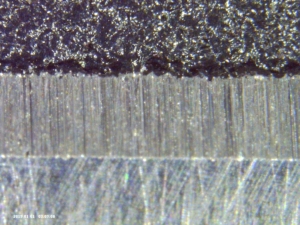How to make a super sharp knife edge
How to create a very sharp edge
The best approach to grind the knife bevel. Grind the bevel using progressively finer grits with the mission of creating a small uniform burr to be removed by an edge honing process leaving a very sharp edge.
It’s all about understanding the material being sharpened, the process being used, and the accuracy of that process.
Note it is important that the burr is suitable for removal by honing (large thick burrs are not suitable for removal by honing)
Our take on burr characteristics regarding positive and negative burrs.
Based on knife grinders’ observations and testing: A very good starting point.
| MALLEABLE POSITIVE BURR | BRITTLE NEGATIVE BURR |
| A high foil-like burr on a thin root.
A burr created edge-trailing, with conventional aluminium oxide and silicon carbide abrasives, and natural stones, using excessive pressure or high grinding speed. |
A small stiff burr on a wide root.
A burr created edge-leading, with CBN/diamond abrasives, using minimal pressure and low grinding speed. |
KG” A good sharpener knows how to apex and deburr the edge; an expert sharpener knows how to clean the apex of the weak wire edge not rounding it”
Positive burr is a light feathery burr commonly produced by an edge trailing grinding process (wheel direction turning away from the edge)
- Determine bevel angle based on steel (reference 1)
2. Set bevel angle using appropriate grit (320, 600?)
3. Set edge using appropriate grit (KG uses 1000)
4. Determine if the burr is positive or negative based on KG chart – steel(reference 2)
5. Differential Honing step 1 (positive for most commercial knives) one at the exact edge angle*, it will hone away the bulk of the burr with a 3-6 micron honing substrate
6. Differential Honing step 2 (positive for most commercial knives ) and the second at a 0.4 – 2 degree higher angle depending on the steel (e.g. a 15 dps edge will be honed at 15.4 – 17 dps), it will hone away the burr root and has 1-micron honing substrate.
Reference 1 – Know your material so that you can choose the best angle – DPS means degrees per side.
- “best performing edge angle is the lowest possible for given steel” (KG 2019)
- “Quality higher-end knives: double-bevel 10 dps, single-bevel 15-16 dps; Mainstream knives: double-bevel 12 dps, single-bevel 20 dps; Wear-resistant premium knives: modern PM steels 13-15 dps, and traditional tool steels 15-20 dps, as explained in the chapter on high end knives (KG 2019)
- “Our sharpening workshop default edge angle for commercial kitchens is 12 dps (KG 2019)
- “Getting rid of the gnarly burr cheapo knives usually produce is so difficult that you can clean the edge apex only at the cost of rounding it (KG 2019)
Reference 2 – Know your material so that you can choose the best deburring method –
- “Positive burrs are produced in tough ductile steels, while negative in hard and brittle. The positive burr base is deburred by honing at a higher than the edge angle, while negative can be deburred by honing at the edge angle (KG 2019)
- “It is plainly impossible to deburr a blade with a malleable burr (formed on mainstream stainless knives) by honing it edge-trailing at the edge angle” (KG 2019) ““Feather burr” and “Foil edge” are two more edge geometries that can be created in the finishing stage of removing the burr; these two are near synonymic and are a product of edge-trailing honing at the edge angle (KG 2019)
- “an edge sharpened at 20 degrees will require more deburring efforts than the edge sharpened at 40 degrees (KG 2019)
- “honing the positive burr at the edge angle shapes it into a wire edge that won’t last, while honing the negative burr at an angle higher than the edge rounds the edge causing an avoidable loss of keenness (KG 2019)
- ” proper deburring requires a minimum of 2 steps”
The Deburring process is a fairly Discreet process , you are removing material, in very small amounts, keep this in mind if you have a large tough burr don’t go at it with a smooth leather wheel.
it you will be there all day and never be successful , go back to your CBN wheels and work thru progressively finer grits until you get a small workable burr .
Examples below
When it is time to debur, If the last stroke was a stroke to the right then the first Debur stroke is a stroke to the right (burr up orientation)
This begins correctly the deburring process by protecting the belt and first op weakening the burr root for a more productive second side stroke.
 Contact Us
Contact Us  Phone
Phone 




